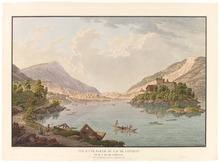
Landslides, also known as landslips, are several forms of mass wasting that may include a wide range of ground movements, such as rockfalls, mudflows, shallow or deep-seated slope failures and debris flows. Landslides occur in a variety of environments, characterized by either steep or gentle slope gradients, from mountain ranges to coastal cliffs or even underwater, in which case they are called submarine landslides.

Lake Zug is a lake in Central Switzerland, situated between Lake Lucerne and Lake Zurich. It stretches for 14 km (8.7 mi) between Arth and the Cham-Zug bay. The Lorze as the main feeder river empties its waters into the lake at its northern extremity, but 1 km (0.6 mi) further west issues from the lake to pursue its course towards the Reuss. Due to this poor feeding, Environmental protection is very important as the lake would suffer long term damage if polluted as the second of the rivers, Rigiaa, feeds only a marginal amount into the lake at its southern end. Already a great part of the fauna in the deep parts of the lake has been lost.There are many turtles in the lake.

Zug is the largest town and capital of the Swiss canton of Zug. Its name, translating from German as "pull" or "tug", originates from the fishing vocabulary; in the Middle Ages it referred to the right to pull up fishing nets and hence to the right to fish.
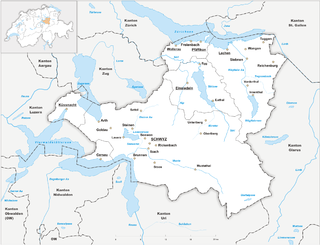
The canton of Schwyz is a canton in central Switzerland between the Alps in the south, Lake Lucerne to the west and Lake Zürich in the north, centred on and named after the town of Schwyz.
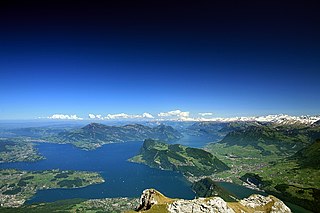
Lake Lucerne is a lake in central Switzerland and the fourth largest in the country.

The canton of Zug or Zoug is one of the 26 cantons of Switzerland. It is located in central Switzerland and its capital is Zug. At 239 km2 (92 sq mi) the canton is one of the smallest of the Swiss cantons in terms of area. It is not subdivided into districts, but eleven municipalities.

Milano Centrale is the main railway station of the city of Milan, Italy, and is the second railway station in Italy for passenger flow and the largest railway station in Europe by volume.
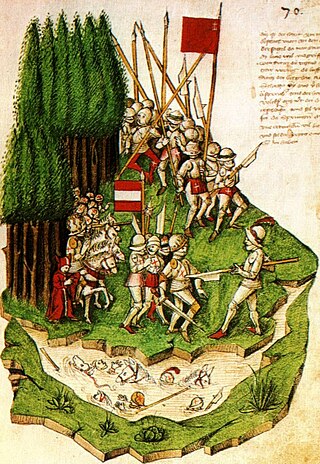
The Battle of Morgarten took place on 15 November 1315, when troops of Schwyz, supported by their allies of Uri and Unterwalden, ambushed an Austrian army under the command of Leopold I, Duke of Austria on the shores of Lake Ägeri, in the territory of Schwyz.
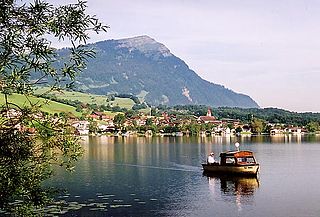
The Rigi is a mountain massif of the Alps, located in Central Switzerland. The whole massif is almost entirely surrounded by the water of three different bodies of water: Lake Lucerne, Lake Zug and Lake Lauerz. The range is in the Schwyzer Alps, and is split between the cantons of Schwyz and Lucerne, although the main summit, named Rigi Kulm, at 1,797 meters above sea level, lies within the canton of Schwyz. The Rigi Kulm Hotel, established in 1816, is located on the summit.

Arth is a village, a town, and a municipality in Schwyz District in the canton of Schwyz in Switzerland.

On February 17, 2006, a massive rock slide-debris avalanche occurred in the Philippine province of Southern Leyte, causing widespread damage and loss of life. The deadly landslide followed a 10-day period of heavy rain and a minor earthquake. The official death toll was 1,126.
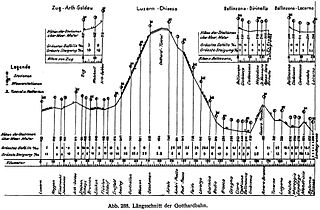
The Gotthard railway is the Swiss trans-alpine railway line from northern Switzerland to the canton of Ticino. The line forms a major part of an important international railway link between northern and southern Europe, especially on the Rotterdam-Basel-Genoa corridor. The Gotthard Railway Company was the former private railway company that financed the construction of and originally operated that line.

Rigi Railways is a railway company that operates a group of railways on the mountain Rigi, located between two of the arms of Lake Lucerne, in Switzerland. They include two standard gauge rack railways, the Vitznau–Rigi Bahn (VRB) and the Arth–Rigi Bahn (ARB), along with the Luftseilbahn Weggis–Rigi Kaltbad (LWRK) cable car.

Greppen is a municipality in the district of Lucerne in the canton of Lucerne in Switzerland.

Lauerz is a village and municipality in the Schwyz District of the canton of Schwyz in Switzerland. It adjoins Lake Lauerz (Lauerzersee).

The Südostbahn – commonly abbreviated to SOB – is a Swiss railway company, and a 1,435 mmstandard gauge network in Central and Eastern Switzerland. It resulted from the merger of the original SOB with the Bodensee–Toggenburg railway (BT) at the end of 2001.

The Tauredunum event of 563 AD was a tsunami on Lake Geneva, triggered by a massive landslide which caused widespread devastation and loss of life along the lakeshore. According to two contemporary chroniclers, the disaster was caused by the collapse of a mountainside at a place called Tauredunum at the eastern end of Lake Geneva. It caused a great wave to sweep the length of the lake, sweeping away villages on the shoreline and striking the city of Geneva with such force that it washed over the city walls and killed many of the inhabitants.
Natur- und Tierpark Goldau is one of six scientifically managed zoos in Switzerland. It is situated in the area that was devastated by the Goldau landslide of 1806. The zoo attracted 859,000 visitors in 2013.

The InterCity are mainline trains in Switzerland connecting the country's major agglomerations, the range of services of which is located between InterRegio (IR) and EuroCity (EC). These trains are generally equipped with air-conditioned equipment, a CFF restaurant or a CFF bistro, a mini-bar service, a quiet area and a business area in 1st class as well as a family area or, occasionally, a family car in 2nd class.

